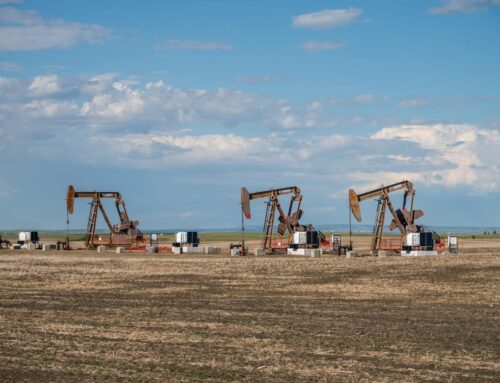On November 12, 2024, the Environmental Protection Agency (EPA) released the final “Waste Emissions Charge for Petroleum and Natural Gas Systems” rule. Created by Congress in 2022, the waste emission charge imposes a fee on methane wasted during oil and gas production. Methane—the largest component of natural gas—is a valuable energy resource that is wasted when it is released into the atmosphere rather than being brought to market, instead becoming a significant source of pollution. The oil and natural gas industry routinely wastes methane, even though the technologies to capture methane at low cost exist. The waste emissions charge applies to large oil and gas facilities for these methane emissions once they exceed a set threshold.
Methane waste costs taxpayers revenue, keeps a valuable energy resource from consumers, and forces communities to shoulder costly liabilities in the form of pollution and extreme weather events. For years TCS has sounded the alarm on methane waste. The oil and natural gas industry, the third-largest industrial source of methane emissions in the U.S., routinely wastes methane through venting, flaring, and leaks. On federal and tribal lands alone, TCS and the Environmental Defense Fund estimate that oil and natural gas operators emitted approximately 163 billion cubic feet of natural gas in 2019, significantly exceeding the volumes operators self-reported. This wasted gas, valued at roughly $509 million, could have powered 2.2 million households for a year.
The final rule released this week is a positive step in curbing methane waste in the oil and gas industry by incentivizing producers to bring more natural gas to market. By targeting facilities with high levels of emissions, the new charge will rein in excessive methane waste and raise money for the federal treasury while also protecting small businesses. The EPA estimates the methane waste fee will raise $2.2 billion in revenue for the U.S. Treasury and reduce methane emissions by 1.2 million metric tons from 2024 to 2035
Under the final rule, large facilities in the oil and gas industry—from production to transportation to processing—that emit more than 25,000 metric tons of carbon dioxide equivalent (CO2e) of greenhouse gases annually are assessed a fee for any methane wasted beyond a congressionally-set threshold. This threshold is determined by the facility’s industry segment. For example, a natural gas pipeline may emit 0.11% of the natural gas it sends to sale over the course of a year, but any methane emissions beyond that are charged. The fee is set at $900/ton in 2024, $1,200/ton in 2025, and $1,500/ton in 2026.
The final rule allows a facility with emissions under the threshold to transfer their “negative” emissions to a different facility owned by the same parent company. For example, assume Facility A and Facility B are both natural gas producers that both sent 20,000,000 metric tons of natural gas to sale in a reporting year, meaning they have the same set emissions threshold of 0.2 percent, or 40,000 metric tons of methane. However, Facility A emitted 45,000 metric tons of methane and Facility B only emitted 35,000 metric tons of methane. Normally, Facility A would have positive net WEC emissions, meaning it must pay a WEC charge, and Facility B would have negative net WEC emissions, meaning no charge was owed. However, if the companies shared the same parent company, Facility B could transfer negative 5,000 metric tons of methane emissions to Facility A, resulting in neither facility owing money.
The final rule, as directed by Congress, also allows for some exemptions, including for:
- Emissions from natural gas used onsite, reinjected into a well, or flared if the natural gas was only used because it could not be sent to sale due to delays in environmental permitting. Only oil and natural gas producers are eligible for this exemption. To qualify, it must have been more than 36 months since the application was submitted and the operator cannot have contributed to the delay.
- Emissions from facilities in compliance with approved state methane plans, as directed by the EPA’s “Standards of Performance for New, Reconstructed, and Modified Sources and Emissions Guidelines for Existing Sources: Oil and Natural Gas Sector Climate Review” rule.
- Emissions from wells that are permanently shut in and plugged. Only oil and natural gas producers and natural gas storage facilities are eligible for this exemption. Qualifying emissions include associated natural gas venting and flaring, leaks from wellhead equipment, liquids unloading, completions and workovers, well testing, and drilling mud degassing.
TCS is concerned that excessive exemptions will limit the effectiveness of the charge and the emissions reduction, resulting in less revenues from the fee for taxpayers and less natural gas brought to market for consumers. In our comments to the EPA, we called on the Administration to increase program transparency and reduce the abuse of exemptions.
The final rule made several significant changes to the proposed rule, which was published in January 2024. Importantly, the final rule expanded allowed exemptions and relaxed the requirements for netting which will result in less facilities and less emissions being charged. These changes include:
- Revisions to the regulatory compliance exemption to allow facilities to be eligible once their state requires compliance with an approved methane plans (“Standards of Performance for New, Reconstructed, and Modified Sources and Emissions Guidelines for Existing Sources: Oil and Natural Gas Sector Climate Review” rule). The proposed rule allowed facilities to be eligible only once all states had approved methane plans but before the state’s mandatory compliance date.
- A laxer approach to netting, which allows facilities under common ownership or control to net emissions across those facilities. The final rule expands the use of netting to the parent company level, which was not allowed under the proposed rule.
- Changes to the “unreasonable delay” exemptions that allow additional emissions—not just flaring, as included in the proposed rule—to be exempted.
- Expanding the plugged well exemptions to wells in the underground storage industry segment and adding associated natural gas venting and flaring as qualifying emissions to be exempted.
The final Waste Emissions Charge will raise revenue, help consumers by bringing more domestic natural gas to market, and protect taxpayers from the long-term liabilities associated with methane emissions. Our statement on the final waste emissions charge rule is available here.
Final Rule Summary
Who will the charge apply to: The waste emissions charge (WEC) applies to facilities in the oil and gas industry (excluding those in the natural gas distribution segment) emitting more than 25,000 metric tons of carbon dioxide equivalent (CO2e) of greenhouse gases annually.
What methane emissions are subject to the charge: Applicable facilities are only charged for methane emissions exceeding a certain threshold, determined as a portion of the total oil or natural gas they send to sale.
| Waste Emissions Threshold for Methane Fees | |
| Oil and natural gas producers | 0.2 percent of natural gas sent to sale, or 10 metric tons of methane per million barrels of oil sent to sale |
| Nonproduction facilities (natural gas processors, liquified natural gas exporters, etc.) | 0.05 percent of natural gas sent to sale |
| Natural gas pipelines and transmission facilities | 0.11 percent of natural gas sent to sale |
For example, if a natural gas pipelines transports 30,000,000 tons of natural gas, it could emit 33,000 tons of methane of methane without incurring any fee. If instead, the facility emits 35,000 tons of methane (which is over 25,000 metric tons CO2e required to be eligible for the WEC), the producer would have to pay the fee on 2,000 tons.
How much will the charge cost: The fee is $900 per ton of methane emitted in 2024, $1,200 per ton in 2025, and $1,500 per ton in 2026.
How Will Netting be Applied: An operator with a negative quantity of net WEC emissions (emissions above 25,000 metric tons but under the threshold) may transfer their negative emissions to another WEC obligated party owned by the same parent company. This only applies to facilities that are WEC-eligible, meaning they emit over 25,000 metric tons CO2e of greenhouse gasses annually.
What Exemptions are Allowed:
- Permitting Delay Exemption
Oil and gas producers can claim the environmental permitting delay exemption for emissions from gas used onsite (as an onsite fuel source or for another beneficial use), reinjected into a well, or flared, if that gas would have been otherwise sold if not for the delay in environmental permitting of gathering or transmission infrastructure. The operator must not have contributed to the delay (e.g. must not be a plaintiff in a lawsuit regarding the environmental permit application, must have timely responses to requests from the permitting agency) and 36 months must have passed since the environmental permit application was submitted.
- Regulatory Compliance Exemption
Under the final rule, compliance with the EPA’s “Standards of Performance for New, Reconstructed, and Modified Sources and Emissions Guidelines for Existing Sources: Oil and Natural Gas Sector Climate Review” (NSPS OOOOb/EG OOOOc) exempts facilities from the waste emissions charge. A facility is eligible for the exemption once it is required to comply with an approved state plan(s). The state plan(s) must result in equivalent or greater emissions reductions as would be achieved by the proposed NSPS OOOOb/EG OOOOc rule—a determination the EPA will make for each state plan. The facility must be in regulatory compliance for the entire reporting year.
- Permanently Shut In and Plugged Well Exemption
Facilities in the oil and natural gas production or natural gas storage industry may receive an exemption for emissions from wells that were permanently shut-in and plugged during the reporting year (site reclamation is not required). Eligible emissions include associated natural gas venting and flaring, leaks from wellhead equipment, liquids unloading, completions and workovers, well testing, and drilling mud degassing.











Get Social